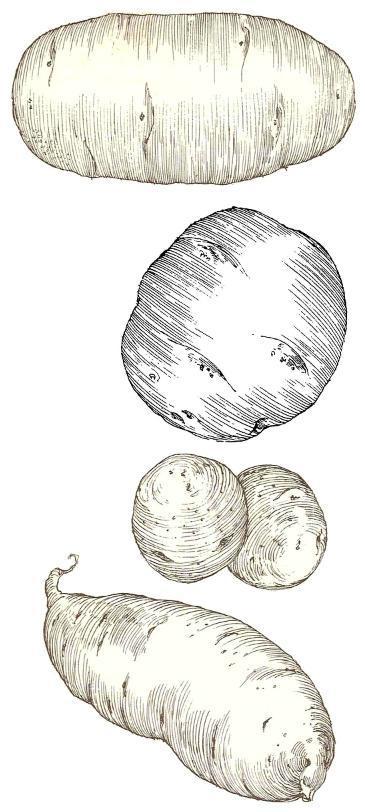 Since most home gardeners start potatoes by cutting and planting last season's tubers, common sense says you should use the healthiest tubers possible.
Since most home gardeners start potatoes by cutting and planting last season's tubers, common sense says you should use the healthiest tubers possible.
How do you acquire disease-free potatoes for planting? Simple, go to a good garden store in the spring and buy certified potatoes for your "seed" or order your seed potatoes from a reliable mail-order source or on-line.
Certified seed potatoes are grown under carefully monitored conditions where state agricultural inspectors enforce high standards of disease and pest control, plant health and quality of harvested tubers. Most certified seed potatoes are grown in northern states where there are fewer disease-spreading insects than in the South. However, the cooler temperatures of the North favor the development of some diseases. Plants that do become infected at the breeding ground can be spotted and eliminated, leaving only the strong disease-free plants.
Gardeners who save some of their own crop to use for seed potatoes the next season are taking a chance. While the tubers may look fine and be perfectly okay for eating, certain virus diseases may be present. If these potatoes were planted, the disease would likely pass from the seed piece to the new plant.
Buying Market Potatoes as StartersPotatoes from the market generally don't make good seed potatoes. They may have diseases and usually are treated with a growth-stopping chemical so that they won't sprout in the stores or in storage. Buying certified seed potatoes locally or through the mail is a better idea.
In many areas, garden stores buy certified seed potatoes in 100-pound bags and break them down into smaller packages for gardeners. How much should you buy? Eight to ten pounds of seed potatoes should plant a 100-foot-row and with that length of row, you could harvest three to four bushels of potatoes if you let them grow to maturity. If you harvest some when they're small for midsummer eating (around flowering time), the total yield will be less. If you get your seed potatoes and can't plant them right away, simply store them in your root cellar or a cool, dark, well-ventilated place.
 Victory Seed Company has all the seeds you want for your best garden in 2024.
Victory Seed Company has all the seeds you want for your best garden in 2024.
For 25 years, the family-owned Victory Seed Company has provided the highest quality vegetable, herb and flower seeds to families across the country. We are passionate about providing you the best seeds available that give excellent germination, robust plants, and the harvest you want. With a catalog of over a thousand varieties, we have everything, and our prices are the kinds that we'd want to pay. We have hundreds of yesterday's heirloom vegetables, as well as today's award winning hybrid selections. Get to know us by visiting our website and browsing through our online vegetable seed catalog.
| 1. Getting Started With Potatoes ← you're on this article right now |
| 2. A Brief History of the Potato |
| 3. How Potatoes Grow |
| 4. Irish Potato Varieties |
| 5. Potato Rotations and pH |
| 6. Soil Preparation for Potatoes |
| 7. Sweet Potato Basics |
| 8. Sweet Potato Varieties |
| 9. Potato Essentials |
| 10. Sweet Potato Essentials |
| 1. Getting Started With Potatoes ← you're on this article right now |
| 2. A Brief History of the Potato |
| 3. How Potatoes Grow |
| 4. Irish Potato Varieties |
| 5. Potato Rotations and pH |
| 6. Soil Preparation for Potatoes |
| 7. Sweet Potato Basics |
| 8. Sweet Potato Varieties |
| 9. Potato Essentials |
| 10. Sweet Potato Essentials |